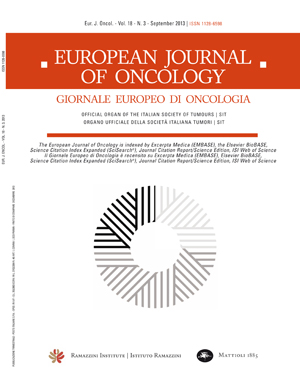Haematopoietic system / Sistema emopoietico (C42.4) - Association of FCGR2A and FCGR3A gene polymorphisms with clinical characteristics and course of diffuse large B-cell lymphoma
Keywords:
diffuse large B-cell lymphoma, FCGR2A and FCGR3A receptors, gene polymorphismsAbstract
Aim: This study aims to assess whether FCGR2A and FCGR3A gene polymorphisms may affect clinical course and outcome in diffuse large B-cell lymphomas (DLBCL) patients treated with R-CHOP therapy. Materials and methods: The study included 64 DLBCL patients treated with R-CHOP. Genotype analyses were performed through PCR-RFLP method. Results: The trend of higher incidence of FCGR3A VF and FF genotypes in patients aged 60 or older (χ2 test, p=0.07) was observed. Significant statistical association between different FCGR2A and FCGR3A gene polymorphisms/genotypes and clinical characteristics (clinical stage, bulky disease, IPI, response to therapy, incidence of relapse and outcome) was not observed, except for FCGR2A HR genotype, which was more frequent in patients with advanced clinical stage (III and IV) (OR 6.11 95% CI 1.18-31.54; RR 1.43 95 CI % 1.06-1.93; p=0.02). However, we observed a trend of better disease free survival (DFS) in patients with FCGR3A FF genotype than in those with VV and VF genotype (log rank test, p=0.05). FCGR2A genotypes did not influence DFS. No association between FCGR2A and FCGR3A gene polymorphisms/genotypes and event free survival (EFS) and overall survival (OS) was observed. Conclusions: Considering clinical features and course of DLBCL, FCGR2A HR genotype is associated with advanced clinical stage of DLBCL. A higher frequency of FCGR3A F allele in DLBCL patients older than 60 years and impact of FCGR3A FF genotype on DFS were noticed only as a trend.Downloads
Published
Issue
Section
License
OPEN ACCESS
All the articles of the European Journal of Oncology and Environmental Health are published with open access under the CC-BY Creative Commons attribution license (the current version is CC-BY, version 4.0 http://creativecommons.org/licenses/by/4.0/). This means that the author(s) retain copyright, but the content is free to download, distribute and adapt for commercial or non-commercial purposes, given appropriate attribution to the original article.
The articles in the previous edition of the Journal (European Journal of Oncology) are made available online with open access under the CC-BY Creative Commons attribution license (the current version is CC-BY, version 4.0 http://creativecommons.org/licenses/by/4.0/).
Upon submission, author(s) grant the Journal the license to publish their original unpublished work within one year, and the non exclusive right to display, store, copy and reuse the content. The CC-BY Creative Commons attribution license enables anyone to use the publication freely, given appropriate attribution to the author(s) and citing the Journal as the original publisher. The CC-BY Creative Commons attribution license does not apply to third-party materials that display a copyright notice to prohibit copying. Unless the third-party content is also subject to a CC-BY Creative Commons attribution license, or an equally permissive license, the author(s) must comply with any third-party copyright notices.

